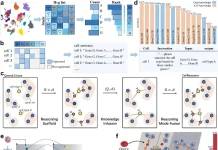A research team at Seoul National University (SNU) developed deep learning technology that can more accurately predict a cancer patient’s survival rate.
According to the research published today in the journal Nature Biomedical Engineering, computational pathology methods for analyzing whole-slide images (WSIs) typically do not take histopathological features from the tumor microenvironment into account.
In this study, the research team demonstrates that a semi-supervised graph deep neural network that considers such contextual features in gigapixel-sized WSIs can provide interpretable prognostic biomarkers.
The researchers created a neural-network model that uses attention techniques to learn characteristics of the heterogeneous tumor microenvironment from memory-efficient representations of aggregates of highly correlated image patches.
Analyzing such microenvironments is critical in cancer diagnosis and predicting survival rates.
The model is trained with WSIs of kidney, breast, lung, and uterine cancers and validated by predicting the prognosis of 3,950 patients with these four different types of cancer.
The first of its kind, graph-based deep learning technology, represents cancer tissues in a network diagram. Unlike previous deep learning-powered diagnosis methods, which could only analyze the shape of each cancer cell, this new technology takes into account the tumor microenvironment, which refers to contextual factors related to cancer tissues such as the distance, interaction, and correlations between immune and cancer cells.
Deep learning technology developed by the SNU research team detects patterns in the tumor microenvironment and measures correlations between cancer and immune cells. Medical personnel can use the compiled and analyzed data to predict a cancer patient’s survival rate.
In collaboration with Seoul National University Hospital, the research team created software using deep learning technology that validated the correlations between cancer cells, immune cells, and blood vessels in cancer tissue as an indicator of a cancer patient’s survival rate.
The model provides interpretable contextual features of clear cell renal cell carcinoma, enabling risk-based retrospective stratification of 1,333 patients.
Deep graph neural networks that extract contextual histopathological features from WSIs could help with next-generation diagnostic and prognostics of cancer.
Story Sources: Lee, Y., Park, J.H., Oh, S. et al. Derivation of prognostic contextual histopathological features from whole-slide images of tumours via graph deep learning. Nat. Biomed. Eng (2022). https://doi.org/10.1038/s41551-022-00923-0
https://koreajoongangdaily.joins.com/2022/08/19/business/tech/Korea-SNU-Deep-learning/20220819160726141.html
Learn More:
Top Bioinformatics Books ↗
Learn more to get deeper insights into the field of bioinformatics.
Top Free Online Bioinformatics Courses ↗
Freely available courses to learn each and every aspect of bioinformatics.
Latest Bioinformatics Breakthroughs ↗
Stay updated with the latest discoveries in the field of bioinformatics.
Dr. Tamanna Anwar is a Scientist and Co-founder of the Centre of Bioinformatics Research and Technology (CBIRT). She is a passionate bioinformatics scientist and a visionary entrepreneur. Dr. Tamanna has worked as a Young Scientist at Jawaharlal Nehru University, New Delhi. She has also worked as a Postdoctoral Fellow at the University of Saskatchewan, Canada. She has several scientific research publications in high-impact research journals. Her latest endeavor is the development of a platform that acts as a one-stop solution for all bioinformatics related information as well as developing a bioinformatics news portal to report cutting-edge bioinformatics breakthroughs.












